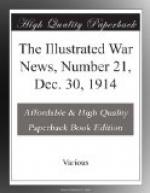_______________________________________________________
___________________ 6—THE ILLUSTRATED WAR NEWS, DEC. 30, 1914.—[Part 21]
But that was nothing to the Christmas Day feat of seven of our sea-planes—one for every day of the week—which, accompanied by light cruisers and destroyers, with several submarines, made a daring and unparalleled attack on Cuxhaven, at the mouth of the Elbe, and several war-ships lying at anchor there—unparalleled, by reason of the fact that this was the first “combined assault of all arms” known to the sea—namely, from the air, the water, and from under the water. Both at Yarmouth and Scarborough the German bombarding cruisers were so nervously afraid of being caught in the act that they may almost be said to have only fired their guns and then run away again. But our triple flotilla at the mouth of the Elbe spent a deliberate three hours in the performance of its task, and then calmly withdrew with only one of the daring pilots missing. So far, it was the most thrilling episode of the war, and must give our enemies “furiously to think,” in addition to furnishing them with much more for the nourishment of their hate. Of this insensate hatred against us in the hearts of the German people—and all because we have “queered their pitch,” or crossed their long-cherished schemes for the destruction of our Empire—the most furious exponent is the Koelnische Zeitung, or Cologne Gazette, as we generally call it—which may be described, on the whole, as the most authoritative organ of the Fatherland—or the Times of Germany, but always with a difference. The curious anomaly is that the seat of this powerful journal should be so far away from the capital—at Cologne. There is an old story—known to tourists who read their guide-books—about the “Three Kings of Cologne,” but now this story has just received a pendant which gives anything but satisfaction at Cologne itself or anywhere else in Germany.
[Illustration: MUCH USED AGAINST SOUTH AFRICAN REBELS: A TRUCK OF AN ARMOURED TRAIN, AT BLOEMFONTEIN.
Armoured trains worked by the South African Engineer Corps have done useful service in the operations against the rebels. The truck in the photograph, it will be seen, is loop-holed.]
This was the recent meeting, not at Cologne, but at Malmoe, of the three Kings of Scandinavia—Denmark, Sweden, and Norway—who lunched, and dined, and debated together for several days, when it was at last announced to the world at large (and Germany in particular) that “their deliberations had not only consolidated the good relations between the three Northern
[Illustration: MEN WHO UNDERGO GREAT HARDSHIPS IN THEIR PURSUIT OF REBELS: A BIVOUAC OF SOUTH AFRICAN LOYALISTS.
Our correspondent writes: “After a long chase they find themselves very often forty miles from the convoy, nothing to eat for man or beast, and in a country destitute of food.”]




